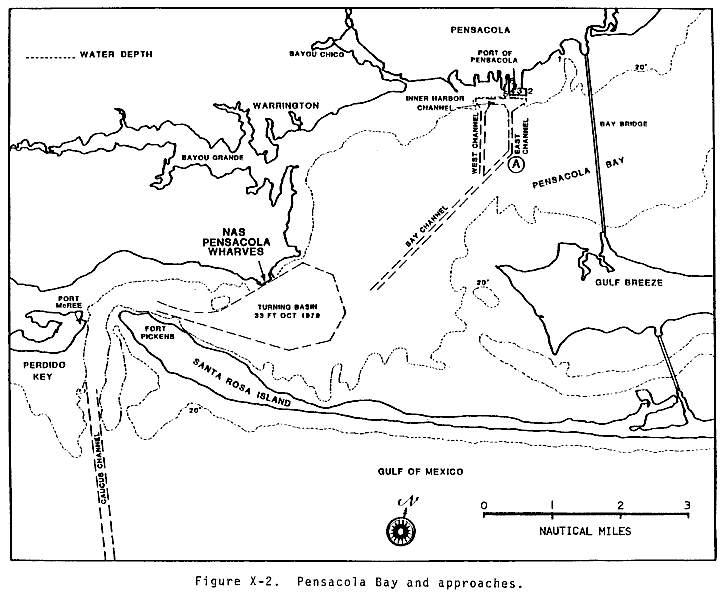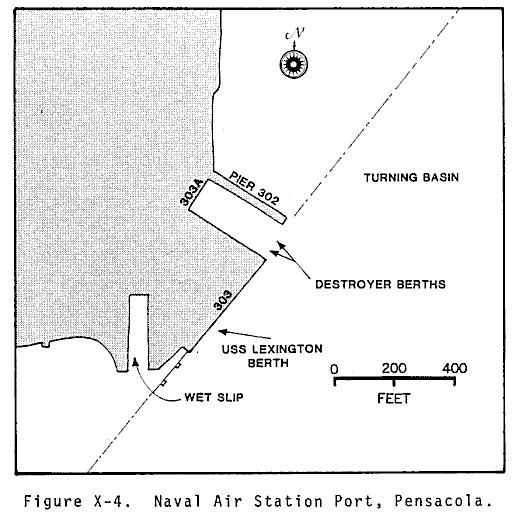



Naval Air Station Pensacola
NAS Pensacola, known as the "Cradle of Naval Aviation," serves as the
launching point for the flight training of every Naval Aviator, Naval Flight
Officer (NFO), and Enlisted Aircrewman. In 1997, about 15,000 aviation personnel in aeronautical technical phases of naval operations were trained there.
Realizing the advantages of the Pensacola harbor and the large timber reserves nearby for shipbuilding, President John Quincy Adams and Secretary of the Navy Samuel Southard, in 1825, made arrangements to build a Navy yard on the Southern tip of Escambia County, where the air station is today. In 1914 the Navy expanded its role in Pensacola development by establishing the US Naval Aeronautical Station. As the Navy expanded, so did support businesses and services- bringing more jobs and workers to the area. The military installations have been a major force in Pensacola's growth.
In 1971 NAS was picked as the headquarters site for Chief of Naval Education and Training [CNET], a new command which combined direction and control of all Navy education and training. The Naval Air Basic Training Command was absorbed by the Naval Air Training Command, which moved to Corpus Christi. Today, the Pensacola Naval Complex in Escambia and Santa Rosa counties employs more than 9,600 military and 6,800 civilian personnel.
The training aircraft carrier USS LEXINGTON (AVT 16) operated out of Pensacola, providing deck-landing and takeoff experience for Naval aviation cadets for over 20 years prior to being decommissioned on 08 November 1991. As of 1989 Navy plans called for moving the operational carrier USS Kitty Hawk (CV 63) to Pensacola, but Kitty Hawk remained homeported in San Diego, California, and eventually departed in July 1998 for Yokosuka, Japan. In February 1992 the USS Forrestal [CV-59] changed her homeport from Mayport, FL, to Pensacola, to become the US Navy's training carrier for naval aviators and support personnel. However, prior to the actual move the overhaul was discontinued in March 1993 when the Forrestal was designated for decommissioning in response to the decision to accelerate the closure of the Pennsylvania Naval Shipyard. USS Forrestal was decommissioned on 11 September 1993.
The Port of Pensacola is located on the north side of Pensacola Bay in the far
west of Florida. The bay is about 13 miles long and 3 miles wide with depths of 20 to 50 ft. The bay is separated from the Gulf of Mexico by Santa Rosa Island, a long and narrow strip of white-sand beach and dunes. Although some of the dunes reach a height of about 15 ft the elevation of the barrier beach generally is less than 10 ft. Santa Rosa Sound, part of the Gulf Intracoastal Waterway, lies between Santa Rosa Island and the Gulf Breeze Peninsula which extends westward into Pensacola Bay. The entrance to Pensacola Bay lies between Fort Pickens on the western tip of Santa Rosa Island and Fort McRee on the eastern tip of Perdido Key. The entrance is approached by Caucus Channel, a 37 ft deep cut dredged through shoals to the south of the coast. Beyond Caucus Channel lies a large turning basin 33 ft in depth.
Facilities at the Naval Air Station (NAS) are located along the northwest edge of the tuning basin. Pier 302 has an alongside depth of not less than 25 ft to the southwest, and Wharf 303, otherwise known as Allegheny Pier, has an alongside depth of not less than 35 ft; the deck height in either case is 11 to 12 ft. For small boats
there is a wet slip a little to the west of Wharf 303. The US Navy maintains 6 tugs, usually tied up in the basin formed by Piers 302 and 303A for servicing the aircraft carrier and destroyer normally based at NAS Pensacola. The aircraft carrier uses Allegheny Pier and the destroyer uses Pier 302.



Sources and Methods
http://www.fas.org/man/dod-101/fac/port/pensacola.htm
Maintained by Robert Sherman
Originally created by John Pike
Updated Sunday, December 06, 1998 5:59:17 AM








